Can a smartphone replace a compact camera?
This comprehensive test of the Samsung S20 Ultra compared to the Panasonic TZ90 and TZ200 will give you the answer.
Panasonic Lumix TZ90 and TZ200 are named ZS70 and ZS200 in the US market.
The Samsung S20 Ultra has three sensors and lenses.
- A sensor of 12000x9000 pixels, or 108 megapixels that can also be used in resolution of 4000x3000 or 12 MP. At 108 MP the images are of poor quality, unless you reduce them to 25% which produces a 27 MP image, in which case the quality is the same as at 12 MP, but with a similar resolution to that of an APS-C camera, which is 24 or 26 MP depending on the model.
This sensor is associated with a large aperture lens of 1.8. - An ultra-wide 13mm sensor with an aperture of 2.2. We won't talk about it in this comparison because no compact offers such a wide view, just know that the image quality here is average.
- A 103mm F3.5 telephoto lens. We will discuss this in detail in the section devoted to zooming.
Sharpness with the main sensor
Its 25mm lens is the equivalent of a 16mm APS-C or a 12mm Micro 4/3. The 103mm telephoto lens corresponds to 67mm or 51mm, so we could compare to an APS-C of 16-67mm or M43 of 12-50, or more, but we will talk about that later. The TZ90 has a focal length of 24-720mm and the TZ200 of 24-360mm.
Cropping on a resized S20 108MP image resized to 20MP, compared to a TZ90 20MP image.
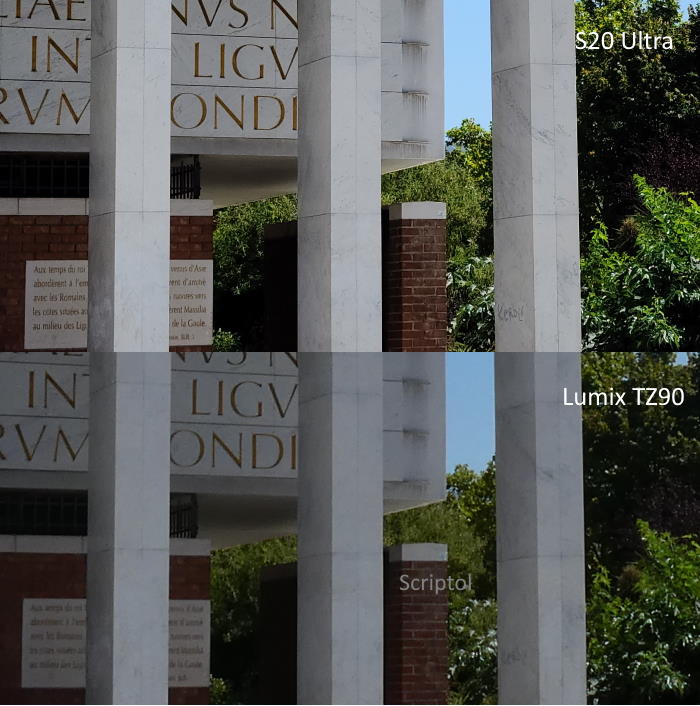
- Bigger picture with the S20 Ultra.
Cropped in a 108 MP photo reduced to 20 MP. - Bigger picture with the TZ90.
Cropped from an 20 MP photo.
The image of the smartphone is sharper and without noise.
Dynamic range: Terrific!
The ability to obtain optimal brightness over the entire frame of a photo, even with in shadow areas, is very good on all recent smartphones.
The image below is a perfect example...
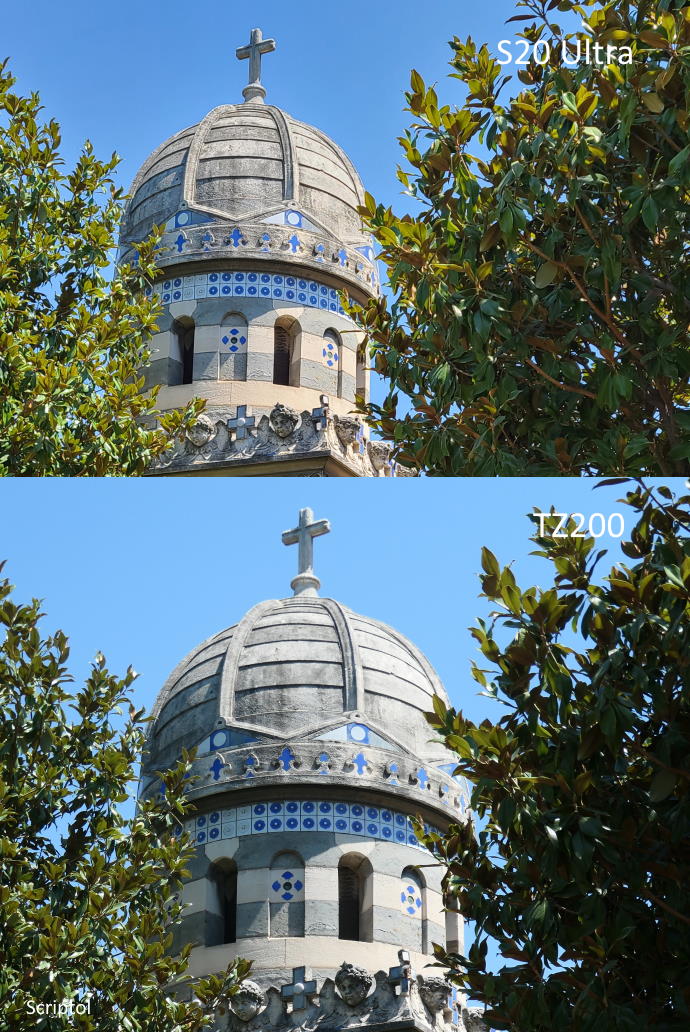
- Bigger picture with the S20 Ultra. Cropped from a 108 MP image scaled down to 20 MP.
- Bigger picture with the TZ200. Cropped from a 20 MP image.
We see that the foliage is clearly visible with the S20 whereas a part of the TZ200 photo is black. It would be worse with the TZ90 and its smaller sensor.
Zoom
The S20 Ultra has a 103mm 12MP telephoto lens that we use here. Beside this focal length all zoom levels are digital, based on the main sensor below 4X and on this telephoto above, up to 100x.
Conversely, the TZ90 has an optical quality zoom of up to 30x (720mm), and the TZ200 up to 15x (360mm). Even if the image loses quality when you approach the maximum focal length, it remains much better than that of a digital zoom.
The photos below were taken indoors where the TZ200 is better than the TZ90. The images are larger because of 20 MP for the compact against 12 MP for the smartphone.
We don't use the Samsung's 108 MP mode here because it needs very good brightness due to its tiny photocytes.
Zoom of 4x or 103mm:
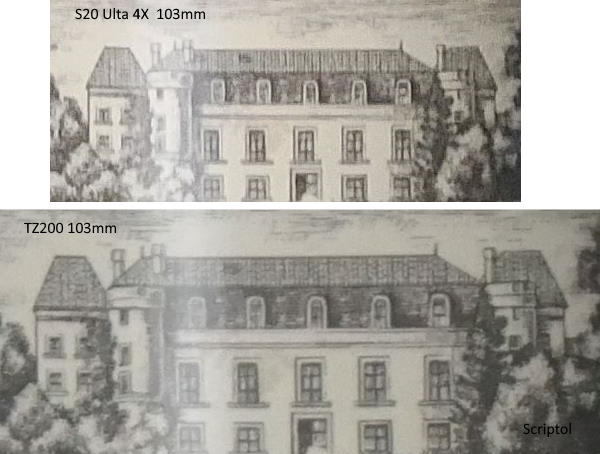
Zoom 6x or 150mm:
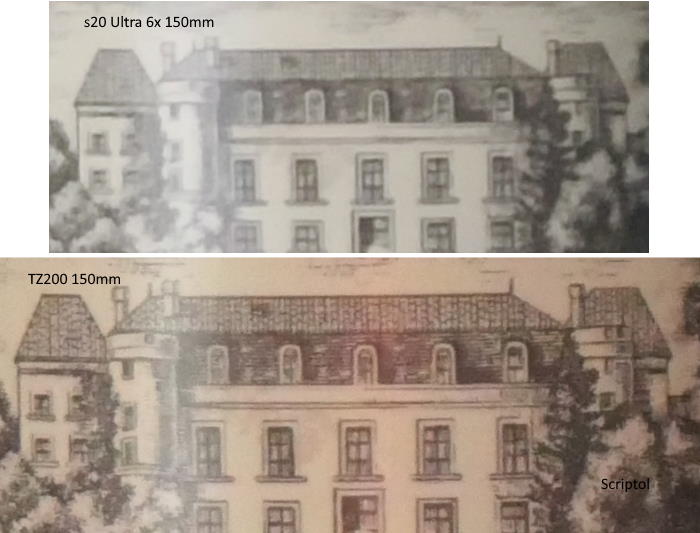
The compact has a clear advantage in 6x with its optical zoom, over the S20 which is digital, but not in 4x.
30x zoom or 750mm and 720mm respectively.
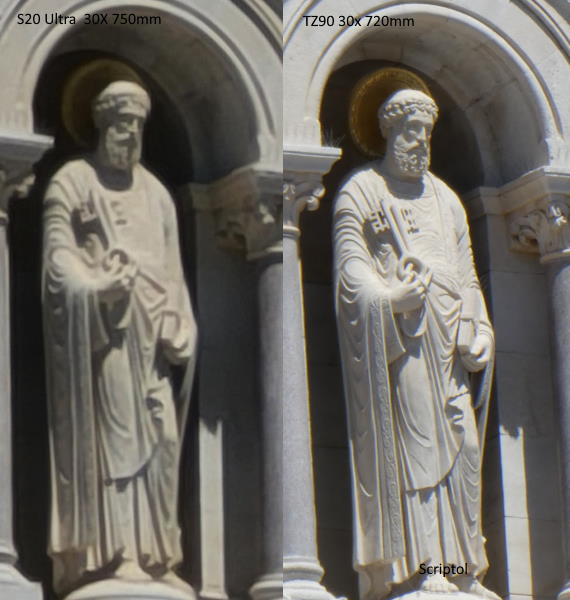
The difference in sharpness here is dramatic. It is clear that if you want to have images taken at long distance without bothering with a bridge (whose image would be even better), the compact remains essential.
Conclusion
When you can use the 108 MP sensor, outdoors in sunny weather, the S20 Ultra provides resized images at 20MP or even 27 MP of better quality than that of a compact (and worth those of an APS-C by the way).
In 12 MP mode 1x or with the 4x zoom, it is still good. The problem is in the intermediate focal lengths, between 25 and 103mm or greater than 103mm. We are then in digital and the sharpness deteriorates.
It's a downside that's fixed, in the tests I've seen, on the Pixel 6 Pro or Samsung S22+, but up to 10x.
It is also possible that installing GCam also offers an improvement, this will be the subject of another test.
A compact camera retains its usefulness for long focal lengths. It also offers other advantages:
- A more practical and faster use with dedicated buttons.
- A viewfinder.
- Often more natural images.
- Tracking autofocus for moving objects.
- An articulated screen.
The smartphone has also advantages:
- Is less bulky.
- Has a higher dynamic range.
- The depth of field is greater.
- There are no crippling on smartphones, the hardware is fully exploited.
See also...
Comparison of smartphone cameras.

